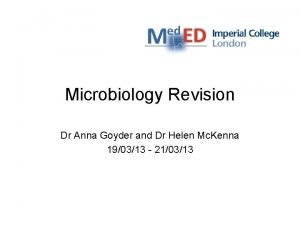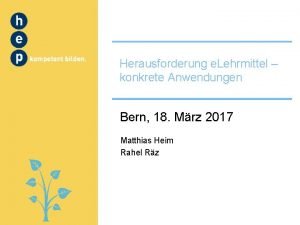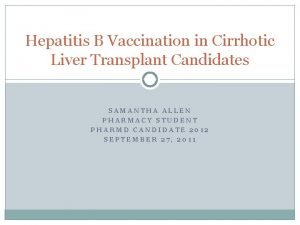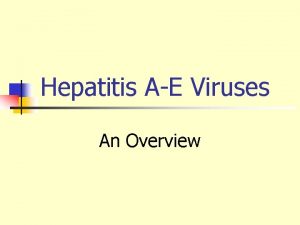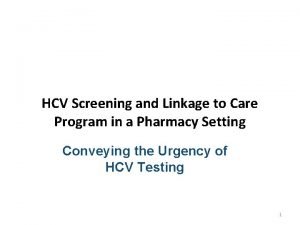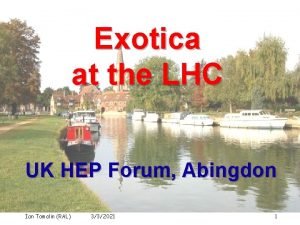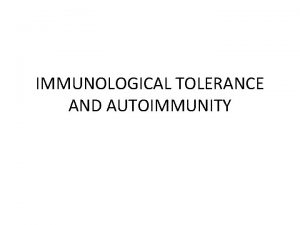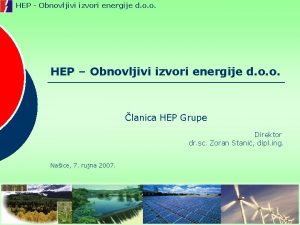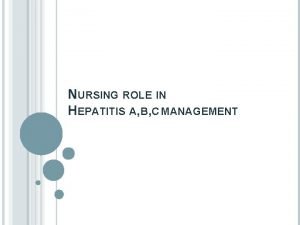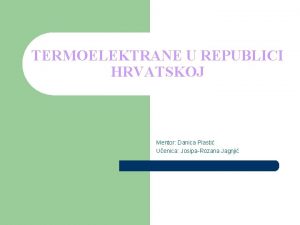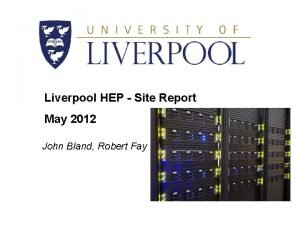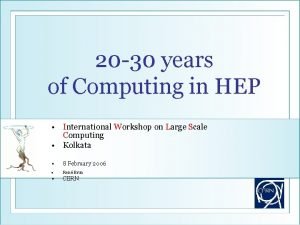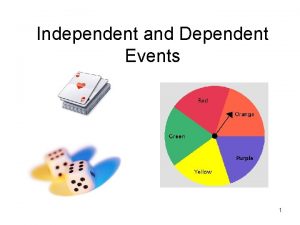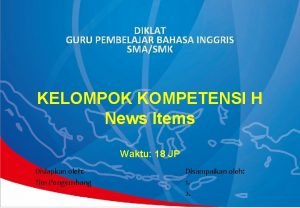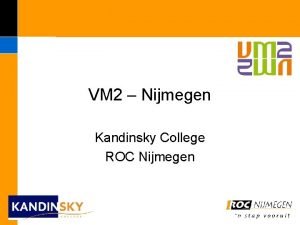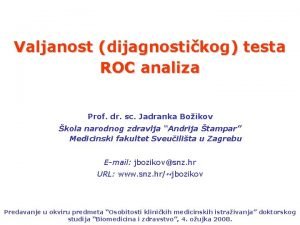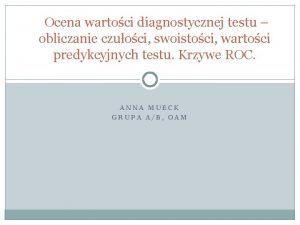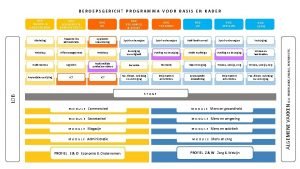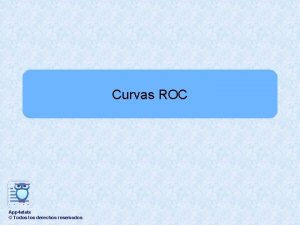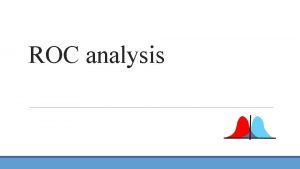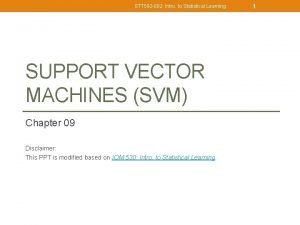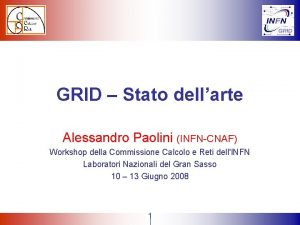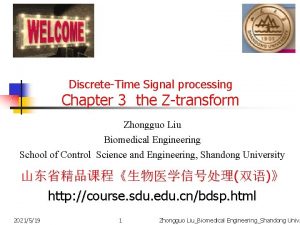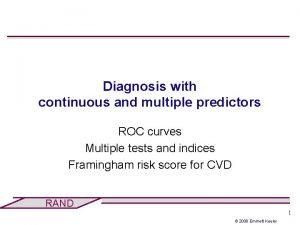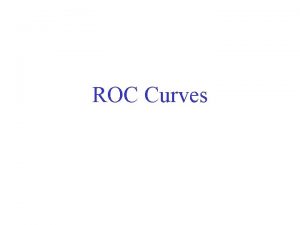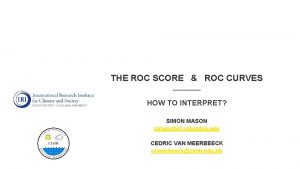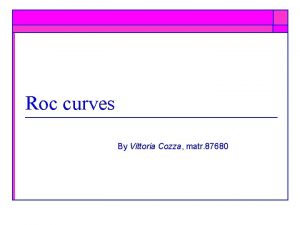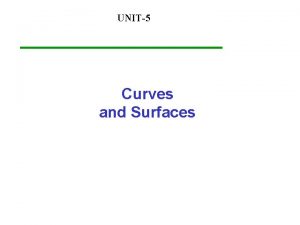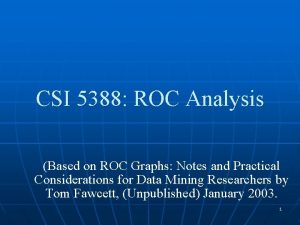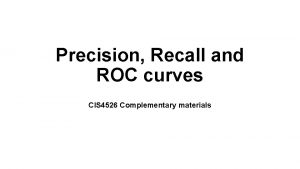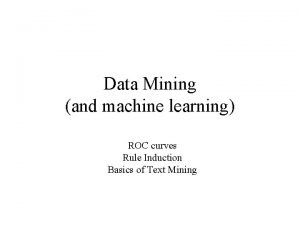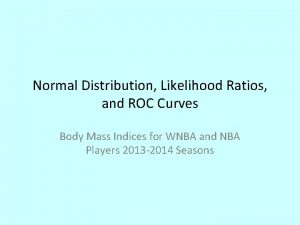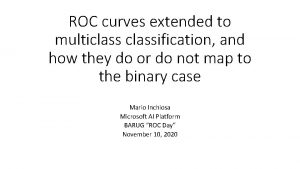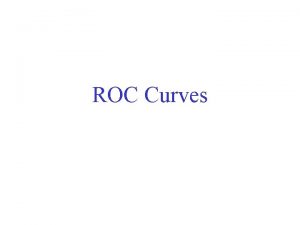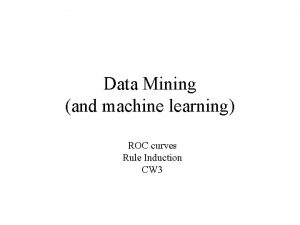ROC curves AUCs and alternatives in HEP event














































- Slides: 46

ROC curves, AUC’s and alternatives in HEP event selection and in other domains Andrea Valassi (IT-DI-LCG) Inter-Experimental LHC Machine Learning WG – 26 th January 2018 Disclaimer: I last did physics analyses more than 15 years ago (mainly statistically-limited precision measurements and combinations – e. g. no searches) A. Valassi – ROC curves and alternatives in HEP IML LHC – 26 th January 2018 1/24

Why and when I got interested in this topic The 2015 LHCb Kaggle ML Challenge - Event selection in search for - Classifier wins if it maximises a weighted ROC AUC - Simplified for Kaggle – real analysis uses CLs • First time I saw an Area Under the Roc Curve (AUC) • My reaction: what is this? is this relevant in HEP? – try to understand why the AUC was introduced in other scientific domains – review common knowledge for optimizing several types of HEP analyses Questions for you – How extensively are AUC’s used in HEP, particularly in event selection? Are there specific HEP problems where it can be shown that AUC’s are relevant? A. Valassi – ROC curves and alternatives in HEP IML LHC – 26 th January 2018 2/24

Spoiler! – What I will argue in this talk • * ROCs are relevant in particle-ID – but this is largely beyond the scope of this talk A. Valassi – ROC curves and alternatives in HEP IML LHC – 26 th January 2018 3/24

Outline • Introduction to binary classifiers: the confusion matrix, ROCs, AUCs, PRCs • Binary classifier evaluation: domain-specific challenges and solutions – Overview of Diagnostic Medicine and Information Retrieval – A systematic analysis and summary of optimizations in HEP event selection • Statistical error optimization in HEP parameter estimation problems – Information metrics and the effect of local efficiency and purity in binned fits – Optimal binning and the relevance of local purity • Conclusions A. Valassi – ROC curves and alternatives in HEP IML LHC – 26 th January 2018 4/24

Binary classifiers: the “confusion matrix” • Data sample containing instances of two classes: Ntot = Stot + Btot – HEP: signal Stot = Ssel + Srej – HEP: background Btot = Bsel + Brej • Discrete binary classifiers assign each instance to one of the two classes – HEP: classified as signal and selected Nsel = Ssel + Bsel – HEP: classified as background and rejected Nrej = Brej + Srej classified as: positives (HEP: selected) classified as: negatives (HEP: rejected) true class: Positives + true class: Negatives - (HEP: signal) (HEP: background) True Positives (TP) (HEP: selected signal Ssel) False Positives (FP) (HEP: selected bkg Bsel) False Negatives (FN) (HEP: rejected signal Srej) True Negatives (TN) (HEP: rejected bkg Brej) I will not discuss multi-classifiers (useful in HEP particle-ID) A. Valassi – ROC curves and alternatives in HEP IML LHC – 26 th January 2018 5/24

The confusion matrix about the confusion matrix. . . Different domains focus on different concepts different terminologies I will cover three domains: - Medical Diagnostics (MED) does Mr. A. have cancer? - Information Retrieval (IR) Google documents about “ROC” - HEP event selection (HEP) select Higgs event candidates MED: prevalence A. Valassi – ROC curves and alternatives in HEP IML LHC – 26 th January 2018 6/24

Discrete vs. Scoring classifiers – ROC curves Reject if D<Dthr Accept if D>Dthr (εs=1 -Dthr) Dthr • Discrete classifiers either select or reject confusion matrix • Scoring classifiers assign score D to each event (e. g. BDT) – ideally related to likelihood that event is signal or background (Neyman-Pearson) – from scoring to discrete: choose a threshold classify as signal if D>Dthr • ROC curves describe how FPR(εb) and TPR(εs) are related when varying Dthr – used initially in radar signal detection and psychophysics (1940 -50’s) A. Valassi – ROC curves and alternatives in HEP IML LHC – 26 th January 2018 7/24

ROC and PRC (precision-recall) curves • Different choice of ratios in the confusion matrix: εs, εb (ROC) or ρ, εs (PRC) • When Btot/Stot (“prevalence”) varies PRC changes, ROC does not Reject if D<Dthr Accept if D>Dthr (εs=1 -Dthr) Dthr A. Valassi – ROC curves and alternatives in HEP IML LHC – 26 th January 2018 8/24

Understanding domain-specific challenges • Many domain-specific details but also general cross-domain questions: – 1. Qualitative imbalance? • Are the two classes equally relevant? – 2. Quantitative imbalance? • Is the prevalence of one class much higher? – 3. Prevalence known? Time invariance? • Is relative prevalence known in advance? Does it vary over time? – 4. Dimensionality? Scale invariance? • Are all 4 elements of the confusion matrix needed? • Is the problem invariant under changes of some of these elements? – 5. Ranking? Binning? • Are all selected instances equally useful? Are they partitioned into subgroups? • Point out properties of MED and IR, attempt a systematic analysis of HEP A. Valassi – ROC curves and alternatives in HEP IML LHC – 26 th January 2018 9/24

Medical diagnostics (1) and ML research - Medical Diagnostics (MED) does Mr. A. have cancer? • Binary classifier optimisation goal: maximise “diagnostic accuracy” – patient / physician / society have different goals many possible definitions • Most popular metric: “accuracy”, or “probability of correct test result”: TP (correctly diagnosed as ill) FP (truly healthy, but diagnosed as ill) FN (truly ill, but TN (correctly diagnosed as healthy) – Symmetric all patients important, both truly ill (TP) and truly healthy (TN) – Also “by far the most commonly used metric” in ML research in the 1990 s • Since the ‘ 90 s shift from ACC to ROC in the MED and ML fields – TPR (sensitivity) and TNR (specificity) studied separately • solves ACC limitations (imbalanced or unknown prevalence – rare diseases, epidemics) – Evaluation often AUC-based two perceived advantages for MED and ML fields • AUC interpretation: “probability that test result of randomly chosen sick subject indicates greater suspicion that of randomly chosen healthy subject” • ROC comparison without prior Dthr choice (prevalence-dependent Dthr choice) A. Valassi – ROC curves and alternatives in HEP IML LHC – 26 th January 2018 10/24

Medical diagnostics (2) and ML research • ROC and AUC metrics currently widely used in the MED and ML fields – Remember: moved because ROC better than ACC with imbalanced data sets • Limitation: evidence that ROC not so good for highly imbalanced data sets – may provide an overly optimistic view of performance – PRC may provide a more informative assessment of performance in this case • PRC-based reanalysis of some data sets in life sciences has been performed • Very active area of research other options proposed (CROC, cost models) – Take-away message: ROC and AUC not always the appropriate solutions A. Valassi – ROC curves and alternatives in HEP IML LHC – 26 th January 2018 11/24

Information Retrieval - Information Retrieval (IR) Google documents about “ROC” • NB: Many different of meanings of “Information”! IR (web documents), HEP (Fisher), Information Theory (Shannon). . . A. Valassi – ROC curves and alternatives in HEP IML LHC – 26 th January 2018 12/24

- HEP event selection (HEP) select Higgs event candidates First (simplest) HEP example • Measurement of a total cross-section σs in a counting experiment • To minimize statistical errors: maximise εs*ρ (well-known since decades) – global efficiency εs=Ssel/Stot and global purity ρ=Ssel/(Ssel+Bsel) – “ 1 single bin” • To compare classifiers (red, green, blue, black): – in each classifier vary Dthr cut vary εs and ρ find maximum of εs*ρ (choose “operating point”) – chose classifier with maximum of εs*ρ out of the four • εs*ρ: metric between 0 and 1 – qualitatively relevant: the higher, the better – numerically: fraction of Fisher information (1/error 2) available after selecting – correct metric only for σs by counting! table with more cases on a next slide A. Valassi – ROC curves and alternatives in HEP IML LHC – 26 th January 2018 13/24

Examples of issues with AUCs – crossing ROCs • Choice of classifier easy if one ROC “dominates” another (higher TPR FPR) – PRC “dominates” too, then – and of course AUC is higher, too • Choice is less obvious if ROCs cross! • Example: cross-section by counting – maximise product εsρ i. e. minimise the statistical error Δσ2 – depending on Stot/Btot, a different classifier (green, red, blue) should be chosen – in two out of three scenarios, the classifier with the highest AUC is not the best • AUC is qualitatively irrelevant (higher is not always better) • AUC is quantitatively irrelevant (0. 75, 0. 90, so what? – εsρ instead means 1/Δσ2. . . ) RED: HIGHEST AUC GREEN: LOWEST ERROR A. Valassi – ROC curves and alternatives in HEP RED: LOWEST ERROR BLUE: LOWEST ERROR IML LHC – 26 th January 2018 14/24

Binary classifiers in HEP - HEP event selection (HEP) select Higgs event candidates Binary classifier optimisation goal: maximise physics reach at a given budget Tracking and particle-ID (event reconstruction) – e. g. fake track rejection maximise identification of particles (all particles within each event are important) Instances: tracks within one event, created by earlier reconstruction stage. P = real tracks, N = fake tracks (ghosts) goal: keep real tracks, reject ghosts TN = fake tracks identified as such and rejected: TN are relevant (IIUC. . . ) [Optimisation: should translate tracking metrics into measurement errors in physics analyses] EVENT SELECTION – I WILL FOCUS ON THIS IN THIS TALK Physics analyses maximise the physics reach, given the available data sets Instances: events, from pre-selected data sets P = signal events, N = background events goal: minimise measurement errors or maximise significance in searches TN = background events identified as such and rejected: TN are irrelevant physics results independent of pre-selection or MC cuts: TN are ill-defined A. Valassi – ROC curves and alternatives in HEP TP = Ssel FP = Bsel FN = Srej TN = Brej IML LHC – 26 th January 2018 15/24

Domain Medical diagnostics Information retrieval HEP event selection Qualitative class imbalance NO. Healthy and ill people have “equal rights”. TN are relevant. YES. “Non-relevant” documents are a nuisance. TN are irrelevant. YES. Background events are a nuisance. TN are irrelevant. Quantitative class imbalance From small to extreme. From common flu to very rare disease. Generally very high. Only very few documents in a repository are relevant. Generally extreme. Signal events are swamped in background events. Varying and unknown in general (e. g. WWW). Constant in time (quantum cross-sections). Unknown for searches. Known for precision measurements. Property . Varying or unknown prevalence π Dimensionality and invariances Different use of selected instances Varying and unknown. Epidemics may spread. 3 ratios εs, εb, π + scale. New metrics under study because ROC ignores π. Costs scale with Ntot. Binning – NO. Ranking – YES? Treat with higher priority patients who are more likely to be ill? 2 ratios εs, ρ + scale. εs, ρ enough in many cases. Costs and speed scale with Ntot. Lumi is needed for: trigger, Show only Nsel docs in one page. syst. vs stat. , searches. TN are irrelevant. Binning – NO. Ranking – YES. Precision at k, R-precision, MAP all involve global precision-recall (“top Nsel documents retrieved) A. Valassi – ROC curves and alternatives in HEP Binning – YES. Fits to distributions: local εs, ρ in each bin rather than global εs, ρ. IML LHC – 26 th January 2018 16/24

Different HEP problems Different metrics Cross-section (1 -bin counting) Statistical error minimization (or statistical significance maximization) Searches (1 -bin counting ) Cross-section (binned fits) Parameter estimation (binned fits) Searches (binned fits) Statistical + Systematic error minimization Trigger optimization Only 2 or 3 global/local variables – TN, AUC irrelevant Binary classifiers for HEP event selection (signal-background discrimination) Simple and CCGV – 2 variables: global Ssel, Bsel (or equivalently εs, ρ) Higgs. ML – 2 variables: global Ssel, Bsel Punzi – 2 variables: global εs, Bsel 3 variables: local ssel, stot, ssel in each bin (2 counts or ratios enough? ) Maximise a sum? * 3 variables: εs, ρ, lumi (lumi: tradeoff stat. vs. syst. ) (may use local Ssel, Bsel in side band bins) 2 variables: global Bsel/time, global εs Maximise εs at given trigger rate No universal recipe * Binary classifiers for HEP problems other than event selection Tracking and Particle-ID optimizations All 4 variables? * (NB: TN is relevant) ROC relevant – is AUC relevant? * Other? * ? * * Many open questions for further research A. Valassi – ROC curves and alternatives in HEP IML LHC – 26 th January 2018 17/24

Predict and optimize statistical errors in binned fits • Fit θ from a binned multi-dimensional distribution – expected counts yi = f(xi, θ)dx = εi*si(θ)+bi depend on parameter θ to fit • Statistical error related to Fisher information (Cramer-Rao) – binned fit combine measurements in each bin, weighed by information • Easy to show (backup slides) that Fisher information in the fit is: – εi and ρi local signal efficiency and purity in the ith bin • Define a binary classifier metric as information fraction to ideal classifier: – in [0, 1] 1 if keep all signal and reject all backgrounds – higher is better maximise IF – interpretation: NB: global ε*ρ is the IF for measuring θ=σs in a 1 -bin fit (counting experiment)! A. Valassi – ROC curves and alternatives in HEP IML LHC – 26 th January 2018 18/24

Numerical tests with a toy model • I used a simple toy model to make some numerical tests – Verify that my formulas are correct – and also illustrate them graphically – Two-dimensional distribution (m, D) signal Gaussian, background exponential • Two measurements: – total cross-section measurement by counting and 1 -D or 2 -D fit – mass measurement by 1 -D or 2 -D fits • Details in the backup slides Using scipy / matplotlib / numpy and iminuit in Python from SWAN A. Valassi – ROC curves and alternatives in HEP IML LHC – 26 th January 2018 19/24

M by 1 D fit to m – optimizing the classifier • A. Valassi – ROC curves and alternatives in HEP IML LHC – 26 th January 2018 20/24

M by 1 D fit to m – visual interpretation • Prediction Fit results Ideal case - yellow histogram (after cuts) coincides with and covers red histogram (ideal) IDEAL CASE, NO BACKGROUND MAXIMUM INFORMATION, MINIMUM ERROR A. Valassi – ROC curves and alternatives in HEP IML LHC – 26 th January 2018 21/24

Optimal partitioning – information inflow • * A. Valassi – ROC curves and alternatives in HEP IML LHC – 26 th January 2018 22/24

Optimal partitioning – optimal variables • Ideal case: ± 0. 200 1 D fit(m), no cut(D): ± 0. 292 1 D fit(m), optimal cut(D): ± 0. 254 2 D fit(m, D), no cuts: ± 0. 233 1 D fit(q): ± 0. 236 A. Valassi – ROC curves and alternatives in HEP IML LHC – 26 th January 2018 23/24

Conclusion and outlook • Different disciplines / problems different challenges different metrics – there is no universal magic solution – and the AUC definitely is not one – I proposed a systematic analysis of many problems in HEP event selection only • True Negatives, ROCs & AUCs are irrelevant in HEP event selection – PRC approach (like IR, unlike MED) more appropriate purity ρ, efficiency εs • Binning in HEP analyses global averages of ρ, εs irrelevant in that case – FOM integrals that are relevant to HEP use local ρ, εs in each bin – AUC is an integral of global ρ, εs one more reason why it is irrelevant – optimal partitioning exists to minimise statistical errors on fits • What am I proposing about ROCs and AUCs, essentially? – stop using AUCs and ROCs in HEP event selection • ROCs confusing they make you think in terms of the wrong metrics – identify the metrics most appropriate to your specific problem • I summarized many metrics that exist for some problems in event selection • more research needed in other problems (e. g. p. ID, systematics in event selection. . . ) I am preparing a paper on this – thank you for your feedback in this meeting! A. Valassi – ROC curves and alternatives in HEP IML LHC – 26 th January 2018 24/24

BACKUP SLIDES A. Valassi – ROC curves and alternatives in HEP IML LHC – 26 th January 2018 25/24

Statistical error in binned fits • A. Valassi – ROC curves and alternatives in HEP IML LHC – 26 th January 2018 26/24

Effect of realistic classifiers on fits • A. Valassi – ROC curves and alternatives in HEP IML LHC – 26 th January 2018 27/24

Information fraction vs. AUC • A. Valassi – ROC curves and alternatives in HEP IML LHC – 26 th January 2018 28/24

Systematic errors • A. Valassi – ROC curves and alternatives in HEP IML LHC – 26 th January 2018 29/24

Maximise εs at 4 k. Hz Trigger IIUC, 4 k. Hz is εb (FPR) = 0. 4% of 1 MHz L 0 hw rate • Different meaning of absolute numbers in the confusion matrix – Trigger events per unit time i. e. trigger rates – (Physics analyses total event sample sizes i. e. total integrated luminosities) • Binary classifier optimisation goal: maximise εs for a given Bsel per unit time – i. e. maximise TP/(TP+FN) for a given FP TN irrelevant • Relevant plot εs vs. Bsel per unit time (i. e. TPR vs FP) – ROC curve (TPR vs. FPR) confusing and irrelevant – e. g. maximise εs for 4 k. Hz trigger rate, whether L 0 rate is 1 MHz or 2 MHz A. Valassi – ROC curves and alternatives in HEP IML LHC – 26 th January 2018 30/24

Event selection in HEP searches • Statistical error in searches by counting experiment “significance” – several metrics but optimization always involves εs, ρ alone TN irrelevant Z 0 – Not recommended? (confuses search with measuring σs once signal established) Z 2 – Most appropriate? (also used as “AMS 2” in Higgs ML challenge) • Several other interesting open questions beyond the scope of this talk – optimization of systematics? e. g. see AMS 1 in Higgs ML challenge – predict significance in a binned fit? integral over Z 2 (=sum of log likelihoods)? A. Valassi – ROC curves and alternatives in HEP IML LHC – 26 th January 2018 31/24

Tracking and particle-ID • ROCs irrelevant in event selection but relevant in other HEP problems • Event reconstruction and particle identification – Binary classifiers on a set of components of one event not on a set of events • Example: fake track rejection in LHCb – data set within one event: “track” objects created by the tracking software • True Positives: tracks that correspond to a charged particle trajectory in MC truth • True Negatives: tracks with no MC truth counterpart relevant and well defined • Binary classifier evaluation: εs and εb both relevant ROC curve relevant – is AUC relevant? maximise physics performance? what if ROC curves cross? – these questions are beyond the scope of this talk A. Valassi – ROC curves and alternatives in HEP IML LHC – 26 th January 2018 32/24

Simple toy model Using scipy / matplotlib / numpy and iminuit in Python from SWAN A. Valassi – ROC curves and alternatives in HEP IML LHC – 26 th January 2018 33/24

M by 1 D fit to m – optimizing the classifier • A. Valassi – ROC curves and alternatives in HEP IML LHC – 26 th January 2018 34/24

M by 1 D fit to m – cross-check • Prediction Fit results (1 fit on 1 sample) Fit results (10 k fits on 10 k samples) A. Valassi – ROC curves and alternatives in HEP IML LHC – 26 th January 2018 35/24

Cross-section by 1 D fit to D i. e. the common practice of “BDT fits” • Prediction A. Valassi – ROC curves and alternatives in HEP Fit results IML LHC – 26 th January 2018 36/24

M by 2 D fit – use classifier to partition, not to cut • Showed a fit for M on m, after a cut on D can also fit in 2 -D with no cuts – again, use the scoring classifier D to partition data, not to reject events • Why is binning so important, especially using a discriminating variable? – next slide. . . Prediction Fit results Ideal case: ± 0. 200 1 D fit(m), no cut(D): ± 0. 292 1 D fit(m), optimal cut(D): ± 0. 254 2 D fit(m, D), no cuts: ± 0. 233 A. Valassi – ROC curves and alternatives in HEP IML LHC – 26 th January 2018 37/24

Optimal partitioning – optimal variables • Ideal case: ± 0. 200 1 D fit(m), no cut(D): ± 0. 292 1 D fit(m), optimal cut(D): ± 0. 254 2 D fit(m, D), no cuts: ± 0. 233 1 D fit(optimal q): : ± 0. 236 A. Valassi – ROC curves and alternatives in HEP IML LHC – 26 th January 2018 38/24

OLDER SLIDES A. Valassi – ROC curves and alternatives in HEP IML LHC – 26 th January 2018 39/24

HEP event selection properties - HEP event selection (HEP) select Higgs event candidates • Binary classifier optimisation goal: maximise physics reach at given budget – Trigger and computing maximise signal event throughput within constraints – Physics analyses maximise physics information from available data sets • I will attempt a systematic analysis of properties: – 1. Qualitative class imbalance signal relevant, background irrelevant • TN irrelevant and ill-defined (preselection, generator cuts) only TP, FN matter – 2. Extreme quantitative class imbalance signal events swamped in background – 3. Prevalence largely constant in time fixed by quantum physics cross section • Prevalence: known in advance for precision measurements; unknown for searches. – 4. Scale invariance (with two exceptions) optimization based on 2 ratios εs, ρ • Exception: trigger rate constraint on throughput of FP(+TP) per unit time • Exception: total error (statistical + systematic) minimization also depends on scale L – 5. Fits to differential distributions local εs, ρ relevant (global εs, ρ ~irrelevant) • More details and examples in the following slides A. Valassi – ROC curves and alternatives in HEP IML LHC – 26 th January 2018 40/24

Medical diagnostics (1) – accuracy - Medical Diagnostics (MED) does Mr. A. have cancer? • Binary classifier optimisation goal: maximise “diagnostic accuracy” – not obvious: many different specific goals many different possible definitions • patient’s perspective minimise diagnostic impact and impact of no/wrong treatment • society’s perspective: ethical and economic allocate healthcare with limited budget • physician’s perspective get knowledge of patient’s condition, manage patient • Most popular metric: “accuracy”, or “probability of correct test result”: True Positives (TP) False Positives (FP) (correctly diagnosed as ill) (truly healthy, but diagnosed as ill) False Negatives (FN) True Negatives (TN) where “prevalence” is (truly ill, but diagnosed as healthy) (correctly diagnosed as healthy) • Symmetric all patients important, both truly ill (TP) and truly healthy (TN) A. Valassi – ROC curves and alternatives in HEP IML LHC – 26 th January 2018 41/24

Medical diagnostics (2) – from ACC to ROC • ACC metric widely used in medical diagnostics in the 1980 -’ 90 s (still now? ) – Also “by far the most commonly used metric” in ML in the 1990 s • Limitation: ACC depends on relative prevalence – issue for imbalanced problems diagnostic accuracy for rare diseases – issue if prevalence unknown or variable over time disease epidemics • Since the ‘ 90 s shift from ACC to ROC in MED and ML fields – TPR (sensitivity) and TNR (specificity) studied separately • reminder: all patients important, both truly ill (TP) and truly healthy (TN) • Evaluation often based on the AUC two advantages for medical diagnostics: – AUC interpretation: “probability that test result of randomly chosen sick subject indicates greater suspicion that of randomly chosen healthy subject” – ROC comparison without prior Dthr choice (prevalence-dependent Dthr choice) A. Valassi – ROC curves and alternatives in HEP IML LHC – 26 th January 2018 42/24

Medical diagnostics (3) – from ROC to PRC? • ROC and AUC metrics currently widely used in medical diagnostics and ML • Limitation: ROC-based evaluation questionable for highly imbalanced data sets – ROC may provide an overly optimistic view of performance with highly skewed data sets • PRC may provide a more informative assessment of performance in this case – PRC-based reanalysis of some data sets in life sciences has been performed • Very active area of research other options proposed (CROC, cost models. . . ) – Take-away message: ROC and AUC not always the appropriate solutions A. Valassi – ROC curves and alternatives in HEP IML LHC – 26 th January 2018 43/24

Simplest HEP example – total cross-section • Total cross-section measurement in a counting experiment • To minimize statistical errors: maximise efficiency*purity εs*ρ – well-known since decades – global efficiency εs=Ssel/Stot and global purity ρ=Ssel/(Ssel+Bsel) – “ 1 single bin” ) el ter d o la m ils y ta To de e or (m • εs*ρ: metric between 0 and 1 – qualitatively relevant (only for this specific use case!): the higher, the better – numerically: fraction of Fisher information (1/error 2) available after selecting A. Valassi – ROC curves and alternatives in HEP IML LHC – 26 th January 2018 44/24

Predict and optimize statistical errors in binned fits • Observed data: event counts ni in m bins of a (multi-D) distribution f(x) – expected counts yi = f(xi, θ)dx depend on a parameter θ that we want to fit – [NB here f is a differential cross section, it is not normalized to 1 like a pdf] • Easy to show (backup slides) that minimum variance achievable is: – (Cramer-Rao lower bound), where (Fisher information) • With an ideal classifier (or no background) yi=Si and • With a realistic classifier and – εi and ρi local signal efficiency and purity in the ith bin • Binary classifier optimization maximise – higher is better – interpretation: A. Valassi – ROC curves and alternatives in HEP IML LHC – 26 th January 2018 45/24

Optimal partitioning – information inflow • A. Valassi – ROC curves and alternatives in HEP IML LHC – 26 th January 2018 46/24
 Compound probability examples
Compound probability examples Abcdl gram positive rods
Abcdl gram positive rods Dalmatur
Dalmatur Hepatitis b vaccine series adults
Hepatitis b vaccine series adults Chronic hepatitis
Chronic hepatitis Hep c results interpretation
Hep c results interpretation Hcv symptoms female
Hcv symptoms female Forum lhc
Forum lhc Immunological tolerance
Immunological tolerance Hep obnovljivi izvori energije
Hep obnovljivi izvori energije Hep b vaccines
Hep b vaccines Hep b vaccines
Hep b vaccines Hepa b
Hepa b Termoelektrana sisak
Termoelektrana sisak Liverpool hep c
Liverpool hep c Hep international
Hep international What does sentinel event mean
What does sentinel event mean Independent or dependent
Independent or dependent Independent vs dependent events
Independent vs dependent events Events management team structure
Events management team structure Bridge breaks in central java the text tells us about
Bridge breaks in central java the text tells us about Chaernobyl
Chaernobyl Roc rooster nijmegen
Roc rooster nijmegen Roc analiza
Roc analiza Roc 800
Roc 800 Rate of change formula
Rate of change formula Krzywą roc
Krzywą roc Uskottavuusosamäärä
Uskottavuusosamäärä How to plot roc curve in excel
How to plot roc curve in excel Z transform
Z transform Roc economie en ondernemen
Roc economie en ondernemen Roc du maroc
Roc du maroc Roc vs sweden
Roc vs sweden Curva roc spss
Curva roc spss Roc
Roc Roc plotter
Roc plotter Roc
Roc Meivakantie rocva
Meivakantie rocva Roc
Roc Roc
Roc Roc to stt
Roc to stt Roc
Roc Inaf27 primaria
Inaf27 primaria Roc
Roc Roc
Roc Roc
Roc Roc curve with multiple predictors
Roc curve with multiple predictors

